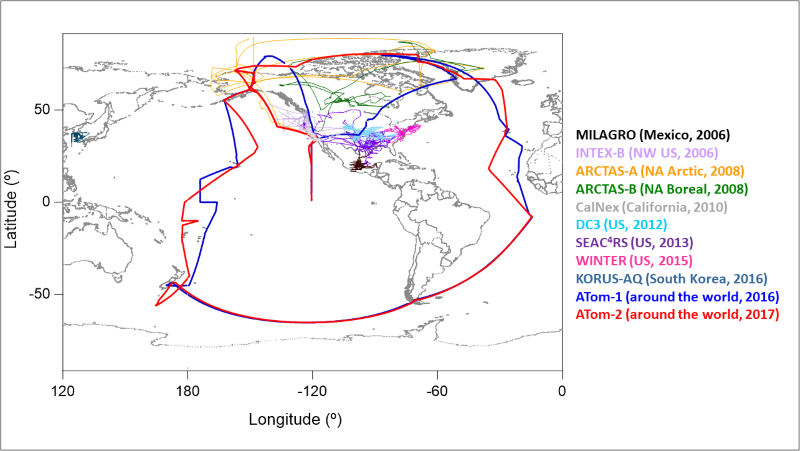The ORNL DAAC recently released the following Atmospheric Tomography Mission (ATom) dataset by Nault, B.A.., et al. (2022):
Airborne Observations and Modeling Comparison of Global Inorganic Aerosol Acidity
This dataset provides observations collected during eleven airborne campaigns from 2006–2017 and associated input and output from nine widely used chemical transport models (CTMs). The airborne campaigns include ARCTAS-A, ARCTAS-B, ATom-1 and ATom-2, CalNex, DC3, INTEX-B, KORUS-AQ, MILAGRO, SEAC4RS, and WINTER, and they sampled mainly tropospheric air over the conterminous U.S. and the state of Alaska, Mexico, Canada, Greenland, and South Korea and remote areas over the Arctic, Pacific, Southern, and Atlantic Oceans. The CTMs are the AM4.1, CCSM4, GEOS-5, GEOS-Chem TOMAS, GEOS-Chem v10, GEOS-Chem v12, GISS-MATRIX, GISS-ModelE, and TM4-ECPL-F, and the output includes sulfate, nitrate, temperature, specific humidity, mixing ratio of ammonium, the volume mixing ratio of nitric acid, surface pressure, gas-phase ammonia, gas-phase nitric acid, pressure, total ammonium, etc. The observations were collected in-situ from a variety of instruments, including the Aerosol Microphysical Properties (AMP), HR Aerodyne Aerosol Mass Spectrometer (AMS), CIT Chemical Ionization Mass Spectrometer (CIMS), diode laser hygrometer (DLH), a mist chamber/ion chromatography system (MC/IC), Particle Analysis by Laser Mass Spectrometer (PALMS), Single Particle Soot Photometer (SP2), and UCI Whole Air Sampler (WAS). In-situ data also include latitude, longitude, and pressure. These observations were used to investigate how aerosol pH and ammonium balance change from polluted to remote regions, such as over oceans, and were compared to predictions from the CTMs.
The Atmospheric Tomography Mission (ATom) is a NASA Earth Venture Suborbital-2 mission to study the impact of human-produced air pollution on greenhouse gases and on chemically reactive gases in the atmosphere. ATom deployed an extensive gas and aerosol payload on the NASA DC-8 aircraft for systematic, global-scale sampling of the atmosphere, profiling continuously from 0.2 to 12 km altitude. Around-the-world flights were conducted in each of four seasons between 2016 and 2018.
Additional data from ATom and other relevant links can be found on the ORNL DAAC's ATom Project Page.
Citation: Nault, B.A., P. Campuzano-Jost, D.A. Day, D.S. Jo, J.C. Schroder, H.M. Allen, R. Bahreini, H. Bian, D.R. Blake, M. Chin, S.L. Clegg, P.R. Colarco, J.D. Crounse, M.J. Cubison, P.F. Decarlo, J.E. Dibb, G.S. Diskin, A. Hodzic, W. Hu, J.M. Katich, J.K. Kodros, A. Kupc, F.D. Lopez-Hilfiker, E.A. Marais, A.M. Middlebrook, J.A. Neuman, J.B. Nowak, B.B. Palm, F. Paulot, J.R. Pierce, G.P. Schill, E. Scheuer, J.A. Thornton, K. Tsigaridis, P.O. Wennberg, C.J. Williamson, and J.L. Jimenez. 2022. Airborne Observations and Modeling Comparison of Global Inorganic Aerosol Acidity. ORNL DAAC, Oak Ridge, Tennessee, USA. https://doi.org/10.3334/ORNLDAAC/1857

